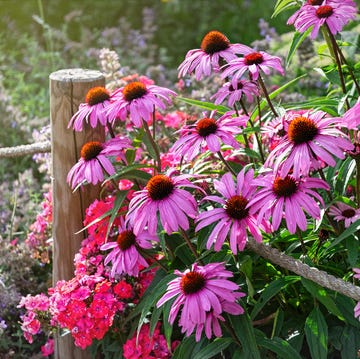1Thyme
 Elizabeth Gaubeka//Getty Images
Elizabeth Gaubeka//Getty ImagesThyme is a low-growing perennial which produces gorgeous tiny pink or purple flowers in early spring. It actually makes a great groundcover with little maintenance. There are many different types including lemon, orange, and lavender thyme.
SHOP NOW
2Oregano
 Westend61//Getty Images
Westend61//Getty ImagesOregano is extremely tough and has tons of tiny white or pinkish flowers throughout the summer that pollinators love. It also drops seeds in the garden, so in a few years you may have a few other oregano plants sprout up. It's one perennial herb that will tolerate a little shade. Oregano is a classic in Mediterranean dishes of all sorts.
SHOP NOW
Advertisement - Continue Reading Below
3Mint
 Les Hirondelles Photography//Getty Images
Les Hirondelles Photography//Getty ImagesBecause mint grows almost like a weed, you'll want to plant it in a container first. Then, submerge the entire pot to ground level to contain its growth. Mint comes in many different flavors including spearmint, chocolate mint, and apple mint. It’s excellent in iced tea, cocktails, and baked goods.
SHOP NOW
4Sage
 letty17//Getty Images
letty17//Getty ImagesSage thrives in the heat and has the most beautiful flowers in late spring. Plus, pollinators love them! Once established, it’s super cold-hardy. It’s perfect when used in cooking meat, soups, stews, vegetables, and making dressing. Consider planting other varieties such as pineapple sage to dress up a fruit salad or add to iced tea.
SHOP NOW
Advertisement - Continue Reading Below
5Rosemary
 Kirill Rudenko//Getty Images
Kirill Rudenko//Getty ImagesFragrant, woodsy rosemary can take a few years to fully mature, so you want to be patient. But once it's ready, it typically blooms in late spring and can come back for a decade. It can also make a lovely houseplant. It doesn't require a lot of water or fertilization either. The telltale earthiness works so well in hearty, savory dishes like stews and braised meats.
SHOP NOW
6Chives
 Joseph De Sciose / Aurora Photos//Getty Images
Joseph De Sciose / Aurora Photos//Getty ImagesChives grow in tidy clumps and are topped with pretty purple flowers in mid-spring. Both the leaves and flowers are completely edible. They also self-sow so new chive plants may pop up in your garden later on. Chives are delicious in potato dishes, soups, salads, and basically any recipe that could use a mild onion flavor.
SHOP NOW
Advertisement - Continue Reading Below
7Cilantro/Coriander
 Flowerphotos//Getty Images
Flowerphotos//Getty ImagesYou might've heard both these terms before and been a little bit confused. To clear things up, cilantro is the leaf, while coriander is the seed which forms after flowering. Cilantro is a cool-weather annual but if it’s left to drop seeds, they’ll sprout again next spring or when temperatures cool down in the fall.
SHOP NOW
8Lavender
 Mytruestory Photography//Getty Images
Mytruestory Photography//Getty ImagesLavender is not only beautiful, but the flowers can also be harvested to add a light flavor to baked goods. Of course, it's also a great ingredient for DIY candles. There are many different varieties so make sure the type you purchase will survive winters in your part of the country.
SHOP NOW
Advertisement - Continue Reading Below
9Dill
 Oleg Charykov//Getty Images
Oleg Charykov//Getty ImagesAlthough dill is an annual, it drops so many seeds after flowering that it will pop up again the following spring. The flowers have a showy, lacy texture that attract pollinators. It’s best used to flavor salads, pickles, and fish dishes.
SHOP NOW
10Garlic Chives
 itographer//Getty Images
itographer//Getty ImagesAs you might have guessed, garlic chives offer a mild garlic flavor. Both the leaves and white flowers, which appear in late summer, are totally edible.
SHOP NOW
Advertisement - Continue Reading Below
11Marjoram
 Creativ Studio Heinemann//Getty Images
Creativ Studio Heinemann//Getty ImagesDepending on where you live, marjoram can be either a perennial (zone 9 and above) or an annual (zones 8 and below). But you can always replant the herb indoors if you live in a colder climate. The leaves are part of the oregano family with a sweeter, more delicate flavor and require consistent watering. Try it with chicken dishes or as a flavor boost to salads.
SHOP NOW
12Fennel
 MIXA//Getty Images
MIXA//Getty ImagesYou may think of fennel as a vegetable and you'd be right. But the flavorful fronds at the top will be just as tasty as the bulb at the bottom. They have a distinct anise flavor like black licorice. Fennel is very easy to grow, is drought tolerant, and needs very little babysitting once established.
SHOP NOW
Advertisement - Continue Reading Below
13Lemon Verbena
 annick vanderschelden photography//Getty Images
annick vanderschelden photography//Getty ImagesA native tropical shrub, lemon verbena prefers frost-free warmer climates but will work well as a house plant in colder climates. The sweet lemon flavor adds a freshness to both sweet and savory dishes. In fact, its fragrance works so well outdoors that you can enjoy the scent outside, too. Just make sure you plant it in an area with good drainage.
SHOP NOW
14Roman Chamomile
 NataliaBulatova//Getty Images
NataliaBulatova//Getty ImagesChamomile produces pretty, daisy-like flowers which can be harvested, dried, and steeped in hot water to make tea. Look for Roman chamomile, which is a perennial, as opposed to German chamomile, which is an annual. Its feathery leaves also make it an attractive groundcover-like plant.
SHOP NOW
Advertisement - Continue Reading Below
15Winter Savory
 Michel VIARD//Getty Images
Michel VIARD//Getty ImagesWinter savory has a low bushy shape with white flowers. It’s related to summer savory, which is an annual, but has a more intense flavor. Add it to fish and meat dishes or sauces for an earthy, pungent flavor that's reminiscent of thyme and mint.
SHOP NOW
16Russian Tarragon
 MarinaParshina//Getty Images
MarinaParshina//Getty ImagesThe delicate blade-like foliage of Russian tarragon can be used dried or fresh in egg, fish, or meat dishes. Its flavor is milder than French tarragon, and is extremely cold-hardy because it originated in Siberia.
SHOP NOW
Advertisement - Continue Reading Below
17Sorrel
 BasieB//Getty Images
BasieB//Getty ImagesSorrel is an heirloom plant that can be tough to classify. Is it an herb? Or is it a type of green? In fact, it fits both categories and is one of the earliest plants to appear come spring. Its bright lemony flavor can be used to add zest to fresh salads or sautéed greens.
SHOP NOW
18Lovage
 woyzzeck//Getty Images
woyzzeck//Getty ImagesLovage is an old-fashioned herb that's mostly overlooked even though it shouldn't be. This hardy plant's leaves have a sweet celery-like flavor. It's heat and cold tolerant and can grow up to five-feet tall in a single season. Try it in soups or salads.
SHOP NOW
Advertisement - Continue Reading Below
19Lemon Balm
 hmproudlove//Getty Images
hmproudlove//Getty ImagesThe lemon-scented mint-like leaves of this perennial herb make it a nice addition to your garden. Remove the flowers so they don’t go to seed, or you may find that this plant will take over your entire garden. It’s mostly used for brewing a cup of delicious tea.
SHOP NOW
20Echinacea
 Helaine Weide//Getty Images
Helaine Weide//Getty ImagesAlso called the coneflower, echinacea is pretty to look at (it's part of the daisy family) and increasingly popular for its homeopathic qualities. If you harvest and dry it, it makes a wonderful tea when you have a cold. The plant is very hardy with deep roots and can be planted in the spring or fall.
SHOP NOW

Arricca Elin SanSone is a writer, editor, and content creator who specializes in lifestyle and gardening. With a background in health reporting, she applies these same research skills when writing about the science of growing things. She trials new plants in her expansive garden, and her houseplant collection consists of 60+ varieties. Arricca has written thousands of articles for publications such as Country Living, House Beautiful, Good Housekeeping, Prevention, VERANDA, Southern Living, and more. She’s happiest when digging in the dirt, baking, or spending time with the people and dogs she loves.
Advertisement - Continue Reading Below
Advertisement - Continue Reading Below
Advertisement - Continue Reading Below

































